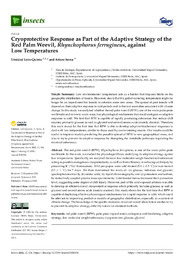Por favor, use este identificador para citar o enlazar este ítem:
https://hdl.handle.net/11000/34861Registro completo de metadatos
| Campo DC | Valor | Lengua/Idioma |
|---|---|---|
| dc.contributor.author | Serna, Arturo | - |
| dc.contributor.author | León-Quinto, Trinidad | - |
| dc.contributor.other | Departamentos de la UMH::Física Aplicada | es_ES |
| dc.contributor.other | Departamentos de la UMH::Agroquímica y Medio Ambiente | - |
| dc.date.accessioned | 2025-01-17T13:16:52Z | - |
| dc.date.available | 2025-01-17T13:16:52Z | - |
| dc.date.created | 2022 | - |
| dc.identifier.citation | Insects | es_ES |
| dc.identifier.isbn | 2075-4450 | - |
| dc.identifier.uri | https://hdl.handle.net/11000/34861 | - |
| dc.description.abstract | The red palm weevil (RPW), Rhynchophorus ferrugineus, is one of the worst palm pests worldwide. In this work, we studied the physiological basis underlying its adaptive strategy against low temperatures. Specifically, we analyzed the main low-molecular-weight biochemical substances acting as possible endogenous cryoprotectants, as well as their efficiency in reducing cold injury by preserving K+/Na+ homeostasis. Wild pre-pupae were cold-treated (5.0 ± 0.5 °C) or non-treated (23 ± 1 °C) for 7 days. We then determined the levels of: (a) glucose, trehalose and glycerol, spectrophotometrically, (b) amino acids, by liquid chromatography and (c) potassium and sodium, by inductively coupled plasma mass-spectrometry. Cold-treated larvae increased their potassium level, suggesting some degree of chill injury. However, part of the cold-exposed animals was able to develop an efficient overall cryoprotective response which primarily includes glucose, as well as glycerol and several amino acids (mainly alanine). Our study shows for the first time that RPW is capable of deploying effective physiological mechanisms for a rapid response to cold, which could be relevant to improving predictive models of geographic distribution, especially in a context of climate change. The knowledge of the specific molecules involved would allow future studies to try to prevent its adaptive strategy, either by natural or chemical methods. | es_ES |
| dc.format | application/pdf | es_ES |
| dc.format.extent | 13 | es_ES |
| dc.language.iso | eng | es_ES |
| dc.publisher | MDPI | es_ES |
| dc.relation.ispartofseries | 13 | es_ES |
| dc.relation.ispartofseries | 2 | es_ES |
| dc.rights | info:eu-repo/semantics/openAccess | es_ES |
| dc.rights | Attribution-NonCommercial-NoDerivatives 4.0 Internacional | * |
| dc.rights.uri | http://creativecommons.org/licenses/by-nc-nd/4.0/ | * |
| dc.subject | red palm weevil (RPW) | es_ES |
| dc.subject | palm pest | es_ES |
| dc.subject | tropical insect | es_ES |
| dc.subject | coleoptera | es_ES |
| dc.subject | cold hardening | es_ES |
| dc.subject | adaptive strategy | es_ES |
| dc.subject | low molecular weight substances | es_ES |
| dc.subject | cryoprotectant | es_ES |
| dc.subject | glucose | es_ES |
| dc.subject | glycerol | es_ES |
| dc.subject.other | CDU::5 - Ciencias puras y naturales::57 - Biología | es_ES |
| dc.title | Cryoprotective Response as Part of the Adaptive Strategy of the Red Palm Weevil, Rhynchophorus ferrugineus, against Low Temperatures | es_ES |
| dc.type | info:eu-repo/semantics/article | es_ES |
| dc.contributor.institute | Institutos de la UMH::Instituto de Bioingeniería | es_ES |
| dc.relation.publisherversion | https://doi.org/10.3390/insects13020134 | es_ES |

Ver/Abrir:
Leon-Quinto and Serna (2022) Insects-13-00134.pdf
1,61 MB
Adobe PDF
Compartir:
 La licencia se describe como: Atribución-NonComercial-NoDerivada 4.0 Internacional.
La licencia se describe como: Atribución-NonComercial-NoDerivada 4.0 Internacional.
.png)